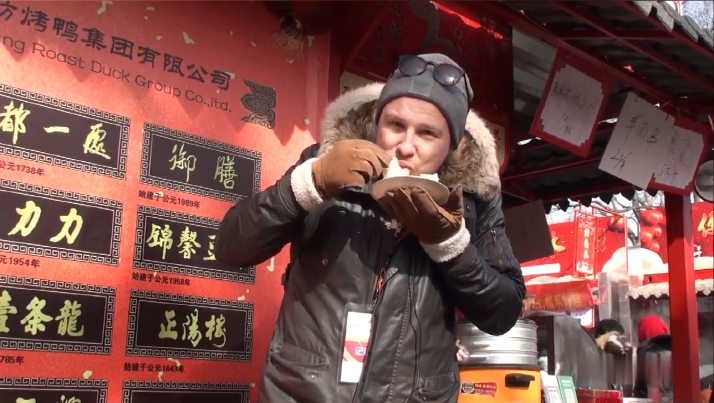| Lifestyle |
| Dumplings, Dragons and Dancing | |
| An afternoon at one of Beijing's legendary temple fairs | |
|
|
 Craig Crowther eats shaomai, steamed dumplings with meat and sticky rice, at the Longtan Temple Fair on February 7 (FILE)
As the mass exodus from Beijing commenced, I was begrudgingly resigned to a week in the city over the Spring Festival holiday. Exorbitant flight prices and a lack of forward planning on my part meant that I was not joining the mass migration. Instead, I was staying home to hibernate from the cold, emerging from my duvet cocoon only for food and other essentials. After a somewhat anti-climactic albeit boozy New Year's Eve, it was time to head off to one of Beijing's famed temple fairs. Temple fairs used to be an ancient Chinese tradition where people gathered to worship deities from local folk religions. The once strong religious connotation is today usurped by a sense of celebration at the arrival of the Lunar New Year. Local families and tourists descend on the fairs in the days succeeding the dawn of the new lunar calendar. We opted to attend the fair at Longtan Park located in central Beijing, which has been entertaining local people during the Lunar New Year for 36 consecutive years. It's the second most popular fair in Beijing after Ditan, or the Temple of Earth, with over 170,000 people visiting in the first two days. Longtan literally means "pool of the dragon," with emblems of the mythical creature visible all across the park, which is one of the largest inside Beijing's Second Ring Road. Somewhat misleadingly, there is no sign of a temple at the Longtan Temple Fair but visitors are privy to plenty of architectures in the style of the Qing Dynasty (1644-1911) decorated with dragon-inspired regalia. The park is festooned with Chinese decorations and lined with craft shops, food stalls and recreational activities. Visitors can sample an array of Chinese dishes, many of which are redolent with symbolism. Tuck into a hearty plate of dumplings, which are especially popular in north China. The name for the dumpling in Chinese is jiaozi, which if pronounced with a different tone means exchange at the midnight hour. Thus the dumpling has come to stand for the welcome transition from one lunar year to the next. The theme of this year's fair was intangible cultural heritage, aiming to maintain once common skills, crafts and traditions, which are now elusive in Chinese society. While a cursory glance from the uneducated eye might lead you to think what is being sold is mere bric-a-brac, each stall is steeped in significance. Take the colored pinwheels, or jixiang lun in Chinese, sold on sticks across the park. While it might seem like a humble toy, in Chinese culture, the spinning spokes symbolize one's luck turning around in the Chinese New Year. One of the most bizarre but unique crafts on sale is the hairy monkey figurines. Known as maohou in Chinese, these intricate ornaments are crafted from the bud of the magnolia flower and the head and legs of a cicada bug. According to legend, a disgruntled employee made the prototype to lampoon his callous boss. Workers at the apothecary are said to have found it so amusing that they then began selling kits for people to make their own. This type of toy has largely been eclipsed by those of the mass-produced variety as China hurtles toward modernization. But the temple fair aims to capture a slice of the past and pass on traditions and cultures to the younger generation. The Chinese New Year has changed rapidly over the past decade. Fireworks are now prohibited in many large cities, people live further away from their families, precluding them from returning home for the festival, and rising incomes have facilitated a rapid increase in international travel. Amid the modernization of the Chinese New Year, the temple fair is a much loved and continued tradition. As well as being an unchanged staple of the holidays, it's one of the few places for people to celebrate in a public forum. With most of the merriments taking place behind closed doors in people's homes, the fairs give locals, expats and visitors the opportunity to come together and rejoice in the party atmosphere as a collective. Akin to the Christmas market in the West, temple fairs provide an opportunity for family and friends to gather, eat traditional foods and buy a quirky souvenir. It's also a welcomed chance to leave the house and enjoy some fresh air after days of family dinners and deliberations. Despite the plummeting temperatures and the crowds of people in attendance, a trip to a temple fair is a must, not just for locals but also for expats and tourists to catch an inside glimpse of China's most important celebration. Copyedited by Sudeshna Sarkar Comments to zanjifang@bjreview.com |
|
||||||||||||||||||||||||||||
|
